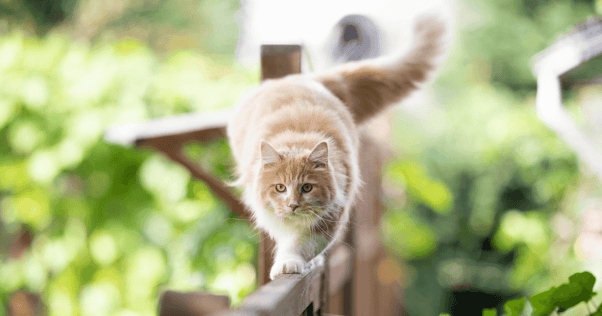Cat Tail Wagging - Just What Does it Mean?
Not only are cat’s tails beautiful, they have practical uses too! Here are some interesting facts about cats and their tails:
- Cats use their tails for balance when running, chasing prey and also when they are walking along the top of a very narrow fence!
- You can see a domestic cat holding its tail vertically when it is walking; in fact it’s the only feline that does this. Big cats don’t hold their tails any higher than horizontally, and will often be seen with their tails tucked down between their legs.
- A cat will greet another cat by putting their tail in the air; this is an invitation to come and have a sniff!
- Cats prefer that we don’t stroke their tail; but they do love to be stroked around their head and neck.
- Importantly, cats use their tails to communicate. We can learn a lot about a cat from their body language, but did you know that a cat’s tail is particularly expressive and tells us a lot about how they are feeling?
Cat Tail Wagging - What Does it Mean?

Tail ‘wagging’ comes in lots of forms: the ‘quiver’, the ‘twitch’, the ‘whip’ or the ‘puff’ and they all mean different things! Let’s explore the valuable information we can glean from a wagging cat’s tail.
A Wagging Tail
A wagging tail doesn’t mean that your cat is happy. When a cat wags their tail, it could mean they are feeling unsure or anxious.
A High Tail
If your cat is approaching you with their tail held high, this means that they are feeling friendly and comfortable! To help keep your kitty feeling this way, you can use FELIWAY Optimum which helps to keep your feline friend serene in difficult situations, so they feel relaxed enough to say ‘hi’ with their tail.
A Quivering High Tail
That little quiver at the top of a high tail is good news when they approach you! It means that they like you very much and are excited to see you!
But just be extra careful! Their tail also quivers when they are urine marking a vertical surface! Urine marking helps cats feel safe and secure by marking their territory and warning other cats to stay away.
A Low Tail
If your cat is carrying their tail low, it could mean they are feeling defensive and uncertain about something. If they are scared, their ears will be flat against their head too.
A Low Hooked-Down Tail
When a cat is in a defensive situation or feeling aggressive, they will hold their tail very low covering their rear end. If they are feeling submissive, their tail is low but curled around their belly.
A Puffed Up Tail
When a cat puffs up their tail (and sometimes also the hair along their spine), they are trying to look bigger as they are feeling fearful and anxious.
A Twitching Tail
This means your cat is feeling agitated by a situation they are experiencing. This may happen when they can’t access something, or their exit is blocked. It can also happen when you are interacting with them; they may twitch their tail to tell you they’ve had enough!
However, if your cat is lying down and their tail is twitching, it could be a sign they are feeling under the weather. Look out for other signs they are unwell; a visit to the vet may be required.
A Tail Whip
Thumping their tail on the ground, and whipping it rapidly is a sure sign that your cat is emotionally stimulated and they may be on the offensive. This can happen if cats are having a disagreement and might be accompanied by raised hair, staring at each other and yowling.
A Swishing Tail
Swishing means they are about to pounce! When cats slowly swish their tail from side to side, it means they are focused on something and are waiting for their chance to pounce on their prey. You will also see them swishing their tail during playtime; a fluffy toy on the end of a string will emulate a prey and pounce game.
A Tail Hug
If your cat has a close relationship with another cat, you may find them wrapping their tails around each other. This is a tail hug - and they may even do this with your hand or arm at the same time as giving you a head butt (which is another sign that you are special to them!)
Using FELIWAY CLASSIC in the home helps cats with more signs of stress, in more situations, and calms cats better than ever - so you can enjoy more tail hugging!

